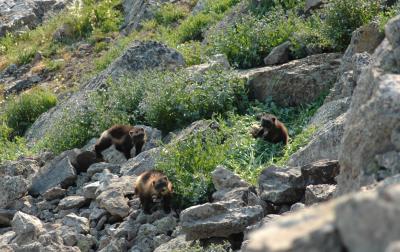An uphill climb for mountain species?

Wolverines depend on the cold snow-pack provided by mountain habitat to den and store food. Credit: Photo credit: Mark Packila
A recently published paper provides a history of scientific research on mountain ecosystems, looks at the issues threatening wildlife in these systems, and sets an agenda for biodiversity conservation throughout the world's mountain regions.
The paper, “Mountain gloom and mountain glory revisited: A survey of conservation, connectivity, and climate change in mountain regions,” appears online in the Journal of Mountain Ecology. Authors are Charles C. Chester of Tufts University, Jodi A. Hilty of the Wildlife Conservation Society, and Lawrence S. Hamilton of World Commission on Protected Areas/IUCN.
Mountains cover about 27 percent of the earth's surface. They inspire awe and cultural lore, and directly influence the patterns of settlement and movement by humans and wildlife. Despite some degree of protection due to their inherent inaccessibility, mountain regions are still fragile ecosystems threatened by human-related impacts such as logging and erosion, acid deposition, and climate change.
For some wildlife species, these impacts are problematic. Wolverines, for example, depend on cold snow-pack to den and store food. As this resource becomes less permanent due to warming, wolverine populations may become physically and genetically isolated—leading to decline of the species
“Scientists and conservationists have long recognized the importance of mountains for both biodiversity and human well-being,” said co-author Charles Chester. “If we are going to achieve effective and lasting protection of wildlife and resources such as water, mountains have to be pre-eminent in our thinking and implementation of conservation measures.”
How do we protect species from human-related impacts and the perils of isolation? The authors examine the concept and importance of maintaining connectivity (ability of wildlife populations to move among landscapes between habitat “islands” such as mountain tops, forest fragments and isolated wetlands) and corridor ecology. Looking at both pro- and con- arguments of an ongoing corridor debate, they present criteria under which corridors may and may not be effective.
The report also examines climate change and its impact on high elevation environments, citing findings that impacts in mountain ecosystems may be greater than any other after those in the arctic. In their conclusion, the authors state that it is important for conservationists to see climate change not as one of numerous independent variables acting on species survival in mountain landscapes, but as an exacerbating force over the many direct human alterations to these areas.
Co-author and Executive Director of WCS's North America Program Jodi Hilty said, “The distribution of biodiversity in mountain ecosystems is determined by such things as elevation and slope. These variables and the relative intactedness of these ecosystems is likely to be a critical factor in maintaining the health of montane species in the face of climate change.”
The authors conclude that three distinct research communities focused on corridor ecology, climate change and mountain research will need to work together and provide support in addressing four key questions:
- What do we need to understand about mountain diversity and its interaction with human communities?
- How can on-the-ground corridors provide sufficient connectivity between natural mountain communities, species and populations.
- To what degree will human-caused climate change require us to modify our response to the first two questions?
- How can we best build resilience into mountain ecosystems?
“Protection of mountain diversity (both biological and cultural) depends on the collaboration of these three research communities in tackling these important questions” said Lawrence (Larry) Hamilton. “Mountains have proven to offer an excellent milieu for both inter- and multi-disciplinary research among the natural sciences, and between natural and social sciences”
Ultimately, the authors state that these questions “encapsulate a unified mountain research agenda.” By a process of answering and reframing the questions, the research community can inform and increase adaptive management capacity.
Media Contact
All latest news from the category: Ecology, The Environment and Conservation
This complex theme deals primarily with interactions between organisms and the environmental factors that impact them, but to a greater extent between individual inanimate environmental factors.
innovations-report offers informative reports and articles on topics such as climate protection, landscape conservation, ecological systems, wildlife and nature parks and ecosystem efficiency and balance.
Newest articles

Nerve cells of blind mice retain their visual function
Nerve cells in the retina were analysed at TU Wien (Vienna) using microelectrodes. They show astonishingly stable behavior – good news for retina implants. The retina is often referred to…

State-wide center for quantum science
Karlsruhe Institute of Technology joins IQST as a new partner. The mission of IQST is to further our understanding of nature and develop innovative technologies based on quantum science by…

Newly designed nanomaterial
…shows promise as antimicrobial agent. Rice scientists develop nanocrystals that kill bacteria under visible light. Newly developed halide perovskite nanocrystals (HPNCs) show potential as antimicrobial agents that are stable, effective…



